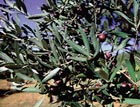Growing olive trees in Provence
The olive tree is a Mediterranean staple, but Louisa Jones wonders from the vantage point of her home in Provence whether so much single-species planting is wise.


June 29, 2006
In a Paris department store recently, I noticed an olive tree emerging from a basket, slim and forlorn, a witness to current fashion. Its cousins now proliferate in many northern gardens, their owners made hopeful by global warming. If the term 'Mediterranean' applies to regions where olive trees thrive outdoors all year round, are London and Paris now Mediterranean? When my husband and I first bought our Rhône valley farmhouse in 1975, we were told it sat right at the northern limit of the olive zone. There, our steeply terraced hillside combines southern and central ecosystems in strange ways: wild thyme grows among the heather.
Early on, clearing away invasive pines and abandoned vines, we discovered many overgrown olive clumps. My husband has since planted whole terraces with root sprouts of the purely local variety. We cherish these trees, but for years left the fruit for the birds, because we did not appreciate the musty taste of oil pressed at the local mill, a quaint family establishment but rarely cleaned. Everyone's olives were pressed together, and the ratio between kilos of fruit delivered and oil returned was somewhat dubious. Truly a story to discourage easy romanticising of old-time country life?
After clearing, we began planting. Time to visit other gardens! But local experts kept telling me, 30 years ago, that there were NO gardens in Provence apart from certain historic sites. I nonetheless managed to see more than 200, of all sizes and kinds, in the following years. My advisors simply meant there were no English gardens with lavish floral displays in July.
Traditional gardens here are largely evergreen with seasonal highlights, floral mainly in the spring. Foliage is often spiky or leathery, a defence against the summer heat and drought, which also concentrates the aromatic oils. Plants grow through the winter, then flower early, so that the long hot season ripens fruit. Olives, the last fruit to be picked, are green in October, then ripen to brown and black through the winter.
The olive tree symbolises Mediterranean living by its blending of use and beauty, antiquity and potential for the future. The New Year in Provence is still celebrated with an olive branch dipped into the newly pressed oil anointing an old Yule log. Oil has been produced here since Greek times, and today new orchards are being planted all over the south ever since word got round that France produces only 15% of the olive oil it consumes. One wonders if so much single-species planting is wise?
In western Provence, frosts that kill trees back to the ground are said to strike every 30 years. Still legendary is 1956, and then there was 1985? Where we live, winters have, in fact, become more severe. We now get snow two or three times a year where once it fell rarely if ever. I believe the experts who predict much local variation in global warming. Not all Mediterranean climate gardeners share my ideals. In California last year, I found foodies keenly discussing oils and the ornamental nurseries had deliberately developed non-fruiting cultivars, dwarf ones for low hedges, and bushy ones for wind breaks. Most of the trees I saw were planted in groups and largely unpruned, even in such a manicured garden as Lotusland.
Exquisite houses, the beauty of Nature, and how to get the most from your life, straight to your inbox.
In France, olive trees are treated as individuals even in orchards, where they are widely spaced. It is felt that they are not only more productive and elegant if well pruned, but also healthier and happier much like roses.
A new olive-oil mill just opened near us, in a beautiful stone house that's been painstakingly restored. The owners, a couple, both grew up here. Decades ago, they ran the first shop offering heirloom and organically grown vegetables. Then came a spell of raising horses in Argentina. Today, back home, he runs the mill and she operates a small cosmetics firm based on olive products. Their new equipment, in accordance with European regulations, can process individually even small batches of olives from individual growers, even home gardeners.
Every year, they give a fête in the new mill. They invite childhood friends, those who stayed on and others who retired here after city jobs. They also invite newcomers 'back to the land' idealists, artists, neo-rural professionals practising télé-travail like ourselves, and business magnates from Paris, Frankfurt and London. All bring their olives to the mill. Another type of new growth on old roots?
This article first appeared in COUNTRY LIFE magazine on June 29, 2006
Country Life is unlike any other magazine: the only glossy weekly on the newsstand and the only magazine that has been guest-edited by His Majesty The King not once, but twice. It is a celebration of modern rural life and all its diverse joys and pleasures — that was first published in Queen Victoria's Diamond Jubilee year. Our eclectic mixture of witty and informative content — from the most up-to-date property news and commentary and a coveted glimpse inside some of the UK's best houses and gardens, to gardening, the arts and interior design, written by experts in their field — still cannot be found in print or online, anywhere else.
